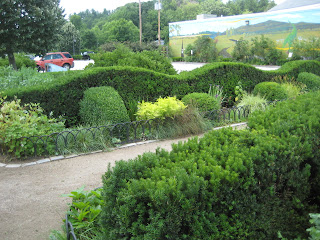The Ruin Garden at Teixeira Park
Textures in the Garden: Calamagrostis brachytricha in the foreground
Volunteer Goldenrod allowed to enter the garden
Echinacea, Butterflyweed and the fine foliage of Vernonia lettermannii 'Iron Butterfly' in foreground
Close up of the original Asclepias tuberosa 'Gay Butterflies' and Heliopsis helianthoides 'Summer Nights'
Asclepias tuberosa 'Gay Butterflies' and Heliopsis helianthoides 'Summer Nights' are the stars of the Ruin Garden in early July. They are good companions. Asclepias tuberosa 'Gay Butterflies' is a short and squat plant of about 24" with bright orange flowers. Heliopsis helianthoides 'Summer Nights' is slim, airy and stands about 3-4 feet tall on elegant red-tinged stems. The golden flowers tower above the low granite walls at the Ruin Garden and can be seen from the sidewalk on Union Street inviting the passerby to explore the garden.
Both plants are cultivars of Native American plants that attract butterflies. The seeds of Heliopsis helianthoides 'Summer Nights' also provide food for goldfinches. Interestingly, both of these plants are self-seeding in the garden. I want the Ruin Garden to have a wild feeling and I am letting some of the volunteers grow where they please but I am editing out other plants that may overwhelm neighboring plants.
This garden is a bit of an experiment for me. I usually like to control what happens in the garden. I am working on removing any unhappy species and letting the happy plants be fruitful and multiply. I want the Ruin Garden to attract birds and butterflies and be full of a diverse combination of plants that look good throughout the year. It is more difficult task to do well than one might think.


















